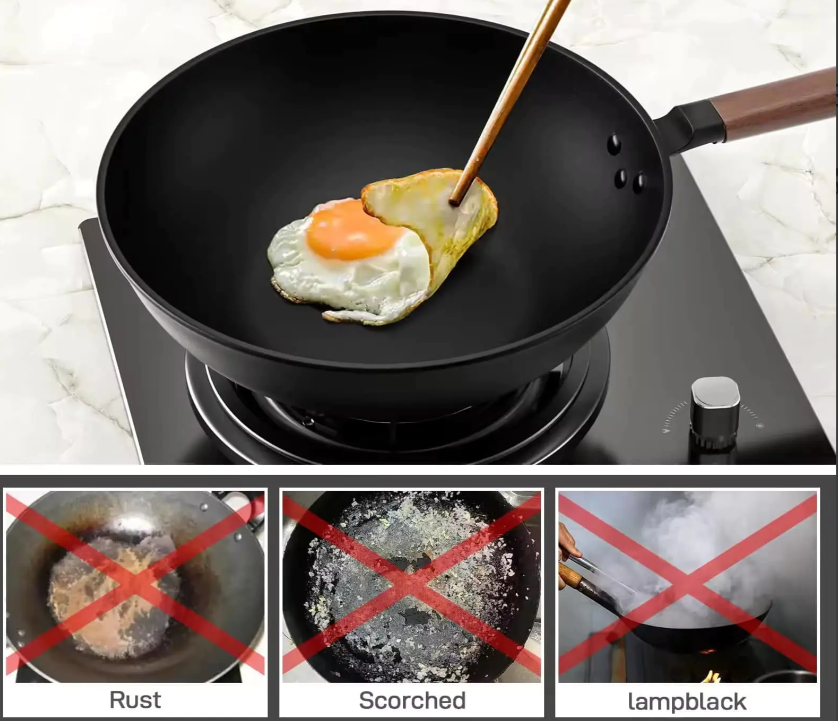Content
1. Why is aluminum non-stick frying pan more fuel-efficient?
Low friction characteristics of non-stick coating
The core technology of non-stick pans lies in their surface coatings (such as PTFE Teflon or ceramic coatings). These materials have extremely low surface energy, making it difficult for food to adhere.
Traditional iron pans: The surface is rough, and grease needs to fill the pores to prevent sticking, so more oil is needed.
Non-stick pans: Smooth coating reduces friction, and only a thin layer of oil is needed to achieve the anti-stick effect, saving 30%~50% of oil.
High thermal conductivity of aluminum
The thermal conductivity of aluminum (237 W/m·K) is much higher than that of stainless steel (16 W/m·K) and cast iron (50 W/m·K), which means:
Quick and uniform heating: reduce local overheating caused by scorching, reduce the need for additional oil.
Cooking with medium or low heat: avoid grease decomposition (such as oil smoke) at high temperatures, which is healthier.
Reduce grease absorption
Traditional pots (such as iron pots) will absorb grease due to "seasoning (oil film maintenance)", while non-stick pots do not need to maintain the pot, only a small amount of oil is needed for each cooking, and long-term use is more fuel-efficient.

2. Health and safety issues of aluminum non-stick pots
- Is the aluminum pot itself safe?
Pure aluminum may precipitate trace aluminum ions in a high-temperature acidic environment, but modern aluminum non-stick pots are usually hard anodized or designed with a composite substrate (such as aluminum + stainless steel interlayer), which effectively isolates aluminum from food contact and meets international food safety standards (such as FDA, EU EN 601).
- Is the non-stick coating (such as Teflon) toxic?
Safe for normal use: PTFE coating is stable below 260℃, and daily cooking (usually 180~220℃) will not release harmful substances.
High temperature risk: It may decompose and produce harmful gases above 300℃, so avoid empty burning or stir-frying.
Ceramic coating: PTFE-free, high temperature resistant (about 400°C), but poor wear resistance and short lifespan.
- Is coating shedding harmful to health?
A small amount of shedding is harmless: PTFE coating itself is chemically inert and will not be absorbed by the human body even if ingested by mistake.
Avoid long-term use of damaged pots: The exposure of aluminum substrates may increase the risk of aluminum ion leakage, and replacement is recommended.
3. How to use aluminum non-stick pans scientifically?
Control the heat: Cook at medium and low temperatures, avoid empty cooking or exceeding 250°C.
Use silicone/wooden kitchen utensils: Metal spatulas can easily scratch the coating.
Clean after cooling: Sudden cooling may cause aluminum deformation, and warm water + soft cloth is best for cleaning.
Check the coating regularly: Replace it in time if obvious scratches or shedding are found.
4.Long-term maintenance tips
- Avoid empty cooking or high-temperature dry cooking
Risk: Empty cooking for more than 5 minutes may cause the temperature to exceed 300°C, causing the PTFE coating to decompose or the aluminum pot to deform.
Correct method: Keep a certain amount of grease or food in the pot during cooking, and control the fire at medium or low (induction cooker recommended ≤1600W).
- Avoid stacking or bumping during storage
Wrong method: Stacking multiple pots will cause friction damage to the coating.
Correct method:
Hang separately or store with soft cloth.
If stacking is necessary, place a layer of kitchen paper or soft rubber pad in the middle.
- Check the coating status regularly
Normal wear: Minor scratches do not affect use.
Situations that require replacement:
Large area of coating peeling (aluminum substrate exposed).
Obvious scratches cause food to stick to the pot frequently.
Common Errors and Corrections
|
Wrong way |
Correct way |
Cause |
|
Pour cold water directly into the hot pan |
Wash with warm water after cooling |
Prevent aluminum deformation and coating cracking |
|
Stir-fry with a metal spatula |
Silicone/wooden spatula |
Avoid scratching the coating |
|
Soak for a long time |
Wash immediately |
Prevent aluminum oxidation and coating aging due to water absorption |
|
Stir-fry over high heat |
Cook over medium or low heat |
Protect the coating and avoid high-temperature decomposition |












